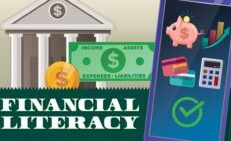Your Credit Score – What You Need To Know
Everyone wants a good credit score, but who knows what that score actually means? Read what your FICO score means and how it impacts you, via Sam Rega.
New Year, New Financial You?
With the new year underway, there’s no better time to get your financial life on track; read how from Michelle Fox.
How to Make Your Financial Life Happier in 2022
New year, new resolutions; in 2022, consider making your money goals focus on happiness. Read more from Anne Tergesen.
It’s Financial Literacy Month!
April is Financial Literacy Month but it’s always a good time to think about what you may, or may not, know. You’re never too old to brush up (or too young to start) on your financial literacy skills. Here are 5 lessons to start you off from A.J. Horch. Read more.
How Important Are Retirement Savings? very, verrrry, VERY!!
How important is saving for retirement? The Social Security Administration’s new study makes the answer pretty clear: very.
The biennial “Income of the Aged” report released this spring examines the retirement income of more than 34 million households, married and single, to produce a financial snapshot of those 65 and older in 2014, the most recent available data.
Savers have nearly doubled the annual income in retirement than nonsavers.
When a household is reduced to one person, income may decrease dramatically.
Income often decreases as a household ages.
Click here to read more about why savings now matter, especially for women.
The Value of Time
When recent retirees are asked whether they would have done anything differently about their retirement planning process, many say they wish they’d started sooner. The mistake that people at all income levels make with retirement accounts is not starting at a younger age.
Time is an important ally when saving and investing, because it allows you to recover from periodic bouts of market volatility. It took five and half years after the vertigo-inducing drop that deleted $11 trillion from stock portfolios for the Dow Jones Industrial Average to regain all of its losses and reach a new high. Those who did not panic and sell their stock investments in 2008-2009 have fully recovered.
Having time on your side makes it easier to accumulate money for retirement, because those who start early don’t have to set aside as much every month. Each decade you delay starting to save means you’ll have to approximately double your savings rate to meet your goal. For example, if socking away 5% per year starting in your early 20 will get you to your goal, waiting until your 30s may mean having to save 10%, and so on.
Time gives you the luxury to be able to develop a plan, and to adjust your savings strategy as you move through your first job, while building your career and preparing for the transition to retirement.
While you’re young, it’s fun to spend money and live in the moment. But, if this describes your philosophy of money, you should motivate yourself to start saving sooner. The longer you wait to save, the more you ultimately will need to save. By making small adjustments in your savings rate now, the easier it will be for you in the long run.
(c) 2013 Kmotion, Inc.*
*Kmotion, Inc., 412 Beavercreek Road, Suite 611, Oregon City, OR 97045; www.kmotion.com
This newsletter is a publication of Kmotion, Inc., whose role is solely that of publisher. The articles and opinions in this publication are for general information only and are not intended to provide tax or legal advice or recommendations for any particular situation or type of retirement plan. Nothing in this publication should be construed as legal or tax guidance; nor as the sole authority on any regulation, law or ruling as it applies to a specific plan or situation. Plan sponsors should consult the plan’s legal counsel or tax advisor for advice regarding plan-specific issues.






